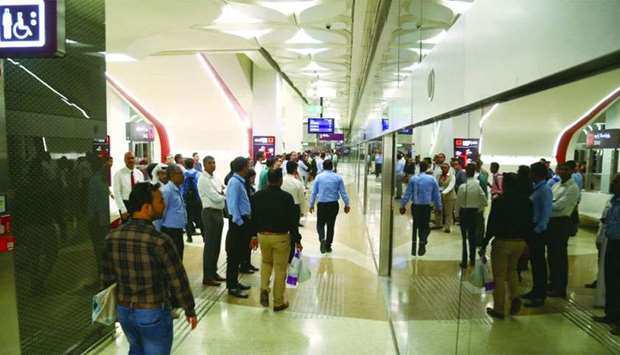The Doha Metro Red Line South, which started its initial operations on May 8, will have new timings after Ramadan, it is learnt.
The service will most likely begin earlier than 8am, aimed at a large number of people who report to work at 7am, according to Qatar Rail's customer service hotline (105).
“The timings right now are for Ramadan but we will have a revised timetable after Ramadan and we will be announcing it in our social media channels so kindly follow us on Twitter, Instagram, and Facebook,” a staff member said.
The Red Line currently operates from 8am to 11pm and its first phase covers 13 of the 18 stations, including Al Qassar, DECC, QIC West Bay, Corniche, Al Bidda (Interchange station), Msheireb (Interchange station), Al Doha Al Jadeda, Umm Ghuwailina, Al Matar Al Qadeem, Oqba Ibn Nafie, Free Zone, Ras Bu Fontas and Al Wakra.
This line will soon open other stations such as Katara, Legtaifiya, Qatar University and Lusail. It operates from Sunday to Thursday and takes a break during the weekends “for the work required to open more stations and lines.”
The staff said that the other Doha Metro lines, as well as the remaining stations of the Red Line, will open in stages and will be fully operational by 2020.
Filipino expatriate Paul N told Gulf Times that the new timings will benefit a large number of employees working at busy areas such as West Bay, Msheireb Downtown Doha (Central Station/Interchange) and Old Airport Road, where a number of metro stations operate.
“I plan to leave home early (Al Hilal) so I can get a parking slot for my car somewhere near the Umm Ghuwailina station and take the train going to the DECC station,” he said, adding that taking a taxi for QR7 or QR8 would be another option.
“I want to avoid heavy traffic in the morning and I think many residents like me will be doing the same because it is really comfortable, affordable and hassle-free,” Paul added.
Passengers who do not want to drive or take a taxi can avail of the free Metrolink feeder bus service to reach the stations as well as to travel to nearby locations from the stations.
Passengers have also been advised to avoid blocking the doors as the train stops at a station and to properly use seats. Eating inside the train is prohibited. Passengers may drink from containers with sealable-tops.
In a series of posts on Twitter recently, Qatar Rail urged passengers not to stand on, sleep on, or block out seats on the Metro with bags.
The full Metro Network
The full metro network consists of three lines; Red, Green and Gold with 37 stations will be in service by 2020.
The Red Line, which runs for 40km from Al Wakra in the south to Lusail in the north, also connects Hamad International Airport at Terminal 1 to the centre of the city. It has 18 stations.
The Legtaifiya Station will also allow passengers to transfer over to the Lusail Tram, in addition to another interchange station between the metro and the tram called Lusail Central. The line offers a very convenient and reliable alternative to driving within the heart of the capital.
The Green Line runs east from Al Mansoura to Al Riffa in the west. As it passes through Education City, the line is also known as the Education Line. There are eleven stations along the line; aside from Education City, notable stops include Hamad Hospital, Al Shaqab, and the Qatar National Library.
The east-west Gold (Historic) Line extends from Ras Bu Abboud to Al Aziziyah. Eleven stations run along the Gold Line, with stops at the National Museum of Qatar, Souq Waqif, and Al Waab (near Villagio Mall).
Al Bidda station provides transfer facility between Red and Green Lines, while Msheireb station provides transfer facility among Red, Green and Gold Lines, according to https://www.qr.com.qa


